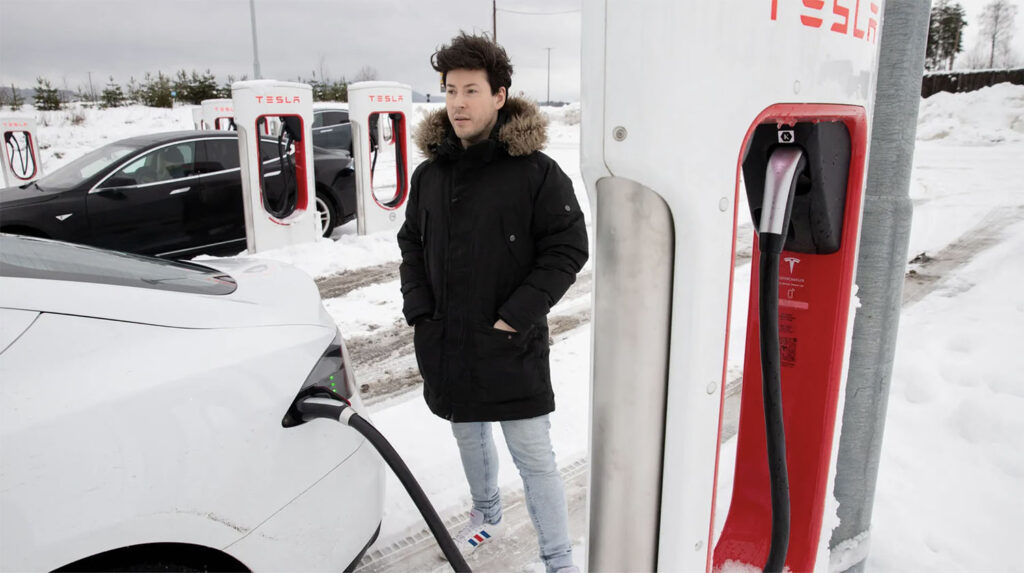By Alliance President Terry Gips
Electric cars are great…till they’re not. While EVs perform far better than gas, from pick-up and zero pollution to no gas lines and lower maintenance costs. What’s not to love? Their performance in frigid winter conditions. The NY Times lays out the cold, hard facts when temperatures sink below zero: “Electric vehicle charging stations have become scenes of desperation: depleted batteries, confrontational drivers and lines stretching out onto the street.” Sadly, my Nissan Leaf stranded me at the airport in extreme cold following a trip.
As one Uber driver said, “When it’s cold like this, cars aren’t functioning well, chargers aren’t functioning well, and people don’t function so well either.” He told the Times he had done little else for three days besides charge his Chevy Volt and worry about again being stranded with a dead battery. He set out for a charging station with 30 miles left on his battery but it was dead within minutes. He had to have his car towed to the station: “When I finally plugged it in, it wasn’t getting any charge.” It took five hours to charge instead of the normal 30 minutes.
The Times reported long lines at Tesla charging stations. One Tesla driver said they normally can drive up to 273 miles on a single, 30-minute charge. However, amidst the extreme cold the Tesla driver lost about a third of their car battery charge. Consequently, the driver spent hours every morning waiting in line to recharge their battery. They commented, “It’s kind of like, I don’t really want a Tesla.”
What Happens to EVs in Frigid Weather
Sadly, freezing temperatures drain batteries and reduce driving range. EVs have two batteries: a low-voltage and a high-voltage. In particularly cold weather, the lower-voltage, 12-volt battery can also lose charge. That’s a frequent problem with all car batteries, whether with gas or EV, but with an EV it can’t charge at a fast charger until the low voltage battery has been jump-started.
That’s what happened to my Nissan Leaf. Even though I got it towed back to my home and plugged it in, I couldn’t start it. The only way I could was after I got a new 12-volt battery. I had thought that simply plugging it in would recharge the 12-volt but it does not if the 12-volt is too depleted. This underscores the importance of EV owners assuring their 12-volt battery is in good condition, which I had not thought about since my Leaf was only 5 years old.
According to UC Irvine Professor Dr. Jack Brouwer, Director of the Clean Energy Institute, “It ends up being very difficult to make battery electric vehicles work in very cold conditions. You cannot charge a battery as fast or discharge a battery as fast if it’s cold. There’s no physical way of getting around.”
Winter Tips for EV Driving
Fortunately, there are some simple steps that you can take to minimize winter challenges. The Zero Emission Transportation Association released a tips sheet for operating electric vehicles in cold weather.
Tesla’s website reminds people that vehicles use more energy to heat their batteries and cabin in cold weather, so it is normal to see energy consumption increase. It offers tips like keeping the charge level above 20% to reduce the impact of freezing temperatures and using its “scheduled departure” feature to register the start of a trip in advance, so the vehicle can determine the best time to start charging and preconditioning. This allows the car to operate at peak efficiency from the moment it starts.
In my case, unless it’s extremely cold, I rely on my electric seat heater, which causes no loss of range, versus a loss of 20 or more miles if my heater is on. This works great for me and one passenger, but for some reason, very few EVs have backseat electric heaters. I’ve shared this concern with dealers and no one seems to know why they aren’t offered. It’s so much more efficient to heat a seat than a space.
I was also told by my Nissan dealer that in extreme cold I should leave my car plugged in overnight to reduce battery drainage, even if it is already fully charged. I always forget, but EV owners in Scandinavia preheat their car ahead of a drive to increase efficiency. They simply set a timer to heat the car 30 minutes before.
Overcoming Hurdles to Going All-Electric
But clearly, there are much larger challenges that must be addressed if we’re going all-electric. Automakers will need to improve vehicle charging. Fortunately, they have been doing that as newer models are more efficient in the cold.
We’ll also need an adequate charging infrastructure. The Times points out that in Norway, where nearly one in four vehicles is electric, charging stations do have longer lines in the winter because vehicles are slower to charge, but that it has become less of an issue in recent years since Norway has built more charging ports. It helps that the majority of Norwegians live in houses rather than apartments and that nearly 90% of EV owners have their own charging stations at home.
In the end, it’s worth the challenge to go EV, even in the winter. While it may be cold outside, our planet is heating up to the point it will become uninhabitable if we don’t drive, bike or walk in a new direction.

